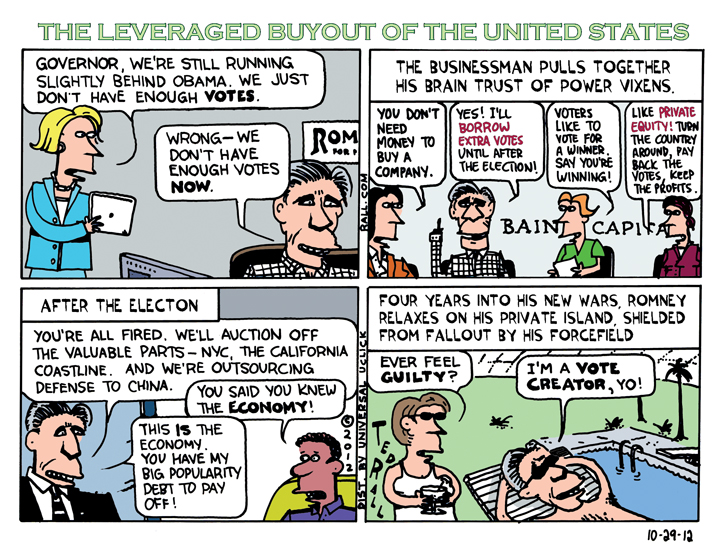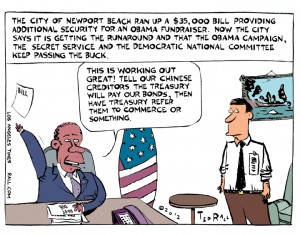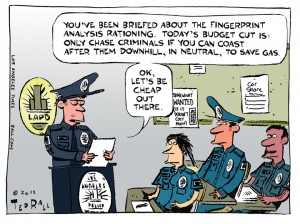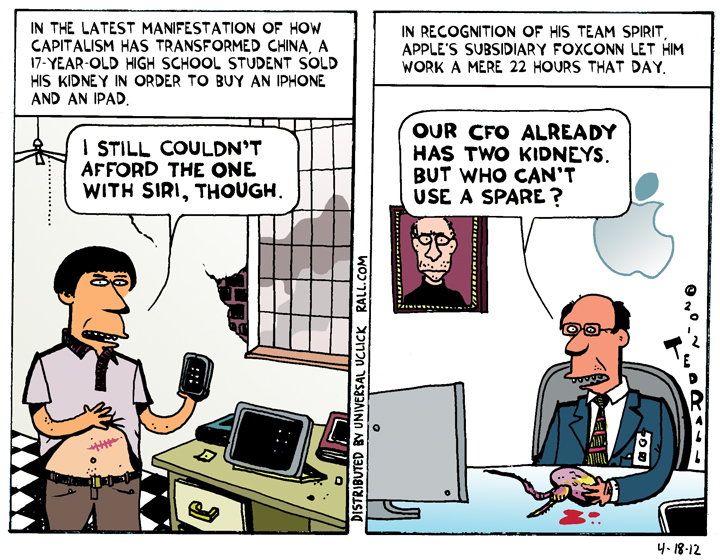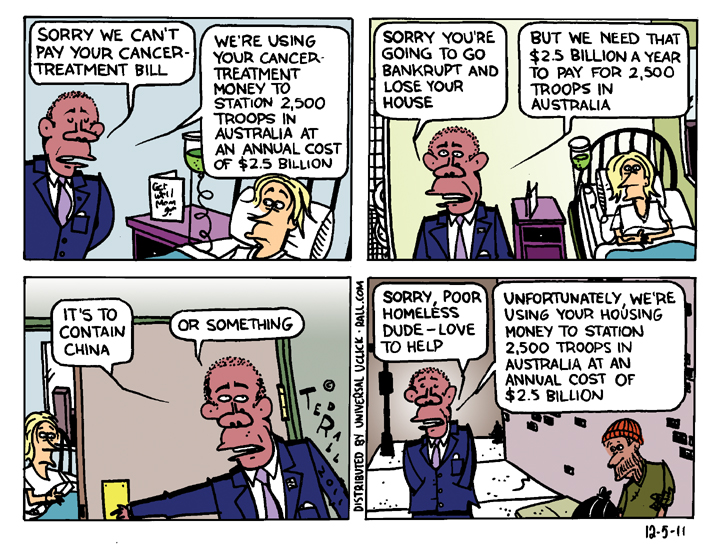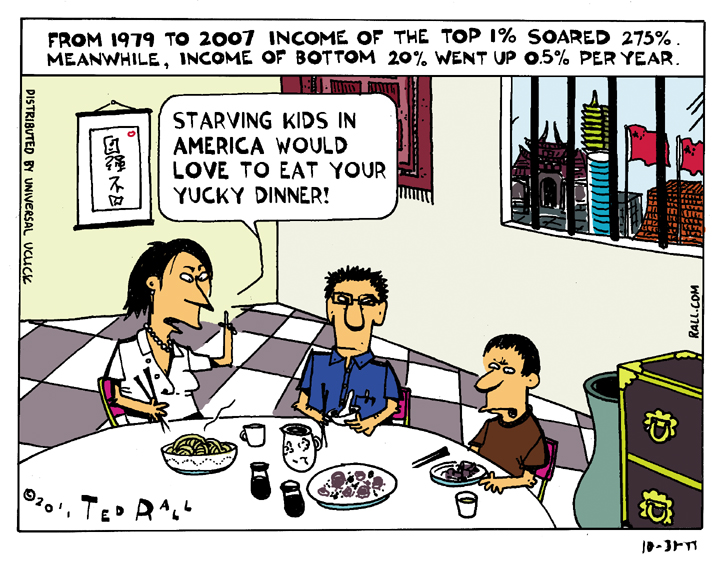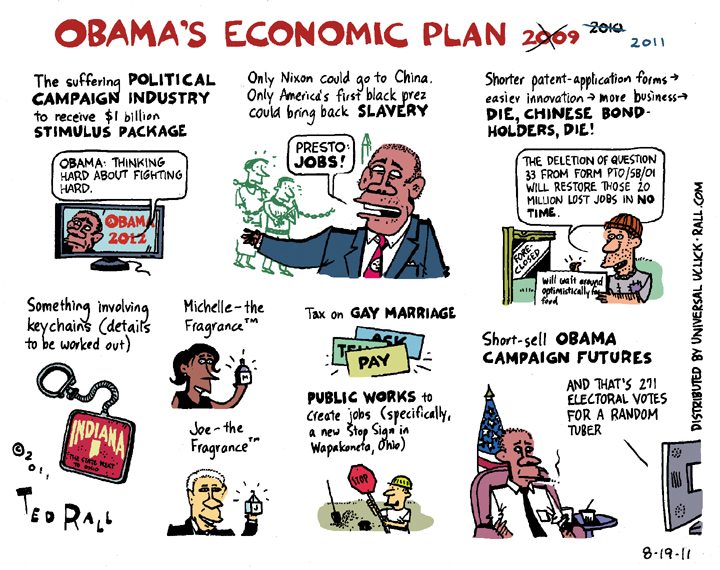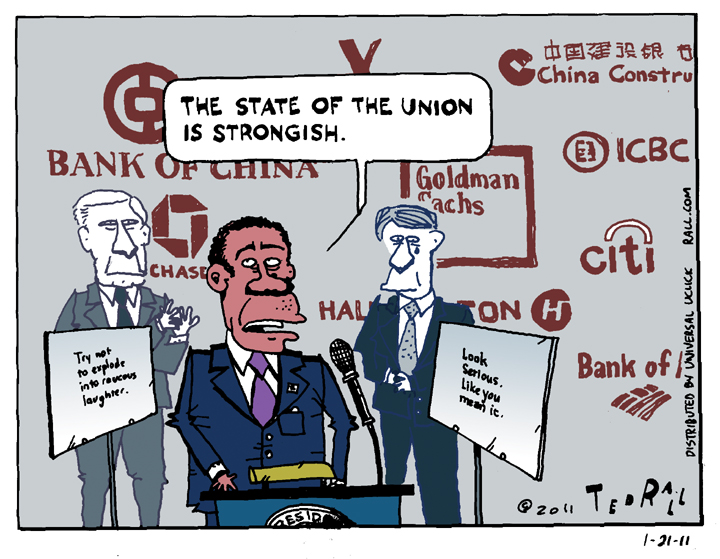Mitt Romney bought companies through LBOs: borrowing the purchase price using the target company itself as collateral, then selling off the profitable parts and cutting loose employees to turn a profit. Now he’s pretending to have votes polls say he doesn’t have, trying to convince undecided voters who want to back a winner to climb aboard his ersatz winning horse. It’s the attempted leveraged buyout of the United States.
SYNDICATED COLUMN: Is America’s Decline Inevitable?
This November: The Pessimist vs. the Cynical Pessimist
This week, decline is on my brain. Specifically, the decline of America.
“There’s not a country on Earth that wouldn’t gladly trade places with the United States of America,” President Obama says, denying Republican assertions that the U.S. is in decline.
(I don’t know about that. Would sick people in the 36 nations that have better healthcare systems than the U.S. want to switch places?)
Clearly we believe our country is in decline—polls show that Americans think that the next generation will live worse than we do. Pessimism about the future is reflected in a 2011 survey in which 57 percent of the public identified the U.S. as the world’s most powerful nation, but just 19 percent thought that we’ll still be #1 20 years from now.
Now The New York Times reports that life expectancy for white people without a high-school degree fell precipitously between 1990 and 2007. It’s shocking news. “We’re used to looking at groups and complaining that their mortality rates haven’t improved fast enough, but to actually go backward is deeply troubling,” the newspaper quoted John G. Haaga, head of the Population and Social Processes Branch of the National Institute on Aging.
“The five-year decline for white women rivals the catastrophic seven-year drop for Russian men in the years after the collapse of the Soviet Union, said Michael Marmot, director of the Institute of Health Equity in London,” reports The Times.
Bear in mind, the study includes the Clinton boom of the 1990s. And it doesn’t include the period after 2007, when the global fiscal crisis set off the current depression. It’s almost certainly worse now.
Even the two major presidential candidates seem to think that the U.S. doesn’t have much of a future. During his “60 Minutes” interview on Sunday, President Obama was asked what his big idea was for his next term. Interviewer Steve Kroft mentioned the Marshall Plan and sending a man to the moon as examples of big ideas.
Obama ducked.
“I think there’s no bigger purpose right now than making sure that if people work hard in this country, they can get ahead,” replied Obama. “That’s the central American idea. That’s how we sent a man to the moon. Because there was an economy that worked for everybody and that allowed us to do that. I think what Americans properly are focused on right now are just the bread-and-butter basics of making sure our economy works for working people.” A nonsensical answer. Yes, we should strive to get back to the lower gap between rich and poor that existed during the 1960s—but lower income inequality didn’t create the space program.
All Obama has to offer is a vague desire to restore the American Dream. Sorry, Mr. President, but getting back something we used to take for granted is the opposite of a big idea.
Though depressing, Obama’s pessimism is dwarfed by Mitt Romney’s.
Romney’s 2011 tax returns reveal that not only did he bet against the value of the American dollar—a staggeringly unpatriotic move for a presidential candidate—he received a quarter of his income from investments in other countries.
Romney, putting his money where his mouth isn’t, is literally betting his millions that the U.S. economy will head south. That the dollar will lose value. That foreign equities will outperform U.S. stocks. He even bought shares in the Chinese state oil company, which has contracts with Iran
He’s worse than a hypocrite. He’s an economic traitor.
Whether better, worse, or the same as today, the U.S. has a future. Who will lead us into that future? The person or movement that can credibly articulate a positive vision of a United States that doesn’t stand still, but actually moves forward–you know, like Obama’s campaign slogan. But who and where are they?
This presidential campaign is shaping up as a race between a pessimist and a cynical pessimist, and in such a contest the mere pessimist is likely to win. But it isn’t good for us in the long run.
“Never have American voters reelected a president whose work they disapprove of as much as Barack Obama’s,” observes the Associated Press’ Bill Barrow. “Not that Mitt Romney can take much comfort—they’ve never elected a challenger they view so negatively, either.”
Obama has the edge in the polls, partly because he presents a less somber vision despite his lack of big ideas. (It helps that Romney is a terrible politician.)
“This is America. We still have the best workers in the world and the best entrepreneurs in the world. We’ve got the best scientists and the best researchers. We’ve got the best colleges and the best universities,” said the President in his “not in decline” remarks. (Never mind that there’s no point going into debt to attend school if there aren’t any jobs when you graduate.)
Well, the United States IS rich. Staggeringly so. The problem is that our wealth has become so unevenly distributed that there is no longer enough consumer demand to support the population. It’s a like a marriage in which both spouses can make it work—if they change their attitudes. If we began focusing on the problems of poverty, unemployment and underemployment, as well as rising income and wealth inequality—i.e., economic injustice—and then fix them—we’ll be OK.
I don’t think we’ll be OK.
The U.S. doesn’t have to be in decline. Some liberal elites, like Fed chairman Ben Bernanke and investor Warren Buffett, understand the need to redistribute wealth. They’re one side of a split in the ruling classes. Unfortunately for the system and for many Americans, they’re losing the argument to greedpigs like Romney.
(Ted Rall‘s new book is “The Book of Obama: How We Went From Hope and Change to the Age of Revolt.” His website is tedrall.com. This column originally appeared at NBCNews.com’s Lean Forward blog.)
COPYRIGHT 2012 TED RALL
LOS ANGELES TIMES CARTOON: A California Town Gets The Runaround
I draw cartoons for The Los Angeles Times about issues related to California and the Southland (metro Los Angeles).
I draw cartoons for The Los Angeles Times about issues related to California and the Southland (metro Los Angeles).
This week: The city of Newport Beach ran up a $35,000 bill providing additional security for an Obama fundraiser. Now the city says it is getting the runaround and that the Obama campaign, the U.S. Secret Service, and the Democratic National Committee keep passing the buck.
SYNDICATED COLUMN: The Occupier’s Choice: Violence or Failure
Don’t Know What They Want, But They Know How To Get It
Here’s how U.S. state-controlled media covered events at Occupy Oakland:
“A day of demonstrations in Oakland that began as a significant step toward expanding the political and economic influence of the Occupy Wall Street movement, ended with police in riot gear arresting dozens of protesters who had marched through downtown to break into a vacant building, shattering windows, spraying graffiti and setting fires along the way,” reported the AP.
Then they quoted an Occupy Oakland member: “‘We go from having a peaceful movement to now just chaos,’ said protester Monique Agnew, 40.”
The lede of this November 3rd AP story frames a larger narrative. “Political and economic influence” cannot be achieved through violence. Ms. Agnew’s quote is used to support that framing. The move from “peace” to “chaos” represents a setback for the Occupy movement.
Violence = tragedy.
Considering that recorded history does not include a single instance of a nonviolent movement effecting radical change, it is interesting that anyone would argue that violence is by definition a negative development. It is equally astonishing that anyone would believe it.
In a revolution, one set of elites gets supplanted by another. There has never been a nonviolent revolution.
Never.
Gandhi was nonviolent. But his allies did resort to violence on numerous occasions. And India wasn’t a revolution. It was an independence struggle. The rich remained rich; the poor stayed poor. Conversely, there has never been a revolution in which violence was the primary tactic. Even the bloodiest revolutions—France, Russia, China—relied more on national strikes, sabotage, marches and demonstrations than shooting people. Revolutions are mostly nonviolent. But violence must always part be of the revolutionist’s toolkit.
Movements move.
Sometimes against the will of many of its members, the nascent Occupy movement is being propelled forward into its second phase: increasingly direct confrontation with the security apparatus of the American police state. The consideration of violence as a tactic is the inevitable result of Occupy’s own internal logic, resulting from a combination of its timing—at a time when revolution is needed and desired by millions of Americans, it’s the only insurrection in town—and its leaderless structure.
Never in history have the wealthy or powerful voluntarily relinquished substantial amounts of money or power. The corporate elite and the political class that enables them—the “1%,” as Occupy calls them—will never give into the Occupier’s demands to reduce their power or wealth unless faced with violence or the credible threat thereof.
As Peter Gelderloos writes in his book How Nonviolence Protects the State: “Time and again, people struggling not for some token reform but for complete liberation—the reclamation of control over our own lives and the power to negotiate our own relationships with the people and the world around us—will find that nonviolence does not work, that we face a self-perpetuating power structure that is immune to appeals to conscience and strong enough to plow over the disobedient and uncooperative.”
If voting or writing letters to the editor worked, we wouldn’t need Occupations.
The Occupy movement can wind up in one of two ways:
Failure.
Or success, partly via the occasional use of violence and/or the credible threat of violence that results from those sporadic outbursts.
First let’s define terms. Vandalism, theft and destruction of property are not violence. Inanimate objects do not suffer. Violence can only be inflicted upon living beings. Breaking a window may or may not be morally justified, but it is never violence. Further, violent self-defense is not the same as violence. Until now the violence at the Occupations has all been initiated by the police. When policemen fire rubber bullets, bean bags, tear gas and pepper spray at unarmed, peaceful protesters, their victims have every right to defend themselves—to run away, to avoid arrest and yes, to strike back.
Every civilized society recognizes the right to self-defense.
Perhaps because they were retroactively spooked by the bombings, bank robberies and kidnappings that marked the disintegration of the Vietnam protest movement, throughout the last 40 years American leftists have adhered to a strict code of militant nonviolence. Abandoning the tactics of disruption and non-cooperation (both of which were central to Gandhi’s approach), demonstrators’ ridiculous cooperation with government authorities reduced progressivism to farce.
Marchers apply for permits on public streets. Organizers give the police pre-printed lists, last name first, of activists who volunteer to be arrested; they are quickly booked and released, rarely less than $100 poorer. It is theater, a mere pantomime of genuine protest.
And it never works. You need only look back at the political history of the United States between 1971 and 2011 to see what 100% nonviolence has accomplished. Even under Democratic presidents and Congressional majorities, the Left has lost one battle after another.
The Left’s only major victory during that period followed the 1999 Battle of Seattle. Riots and broken windows disrupted the World Trade Organization for years. Countless American jobs were saved as a result. Yet liberals were ashamed.
Violence! How terrible!
Not as terrible as the wars and the massive unemployment, apparently.
At the core of the cowardice of protests carried out by establishment liberals has been slavish adherence to nonviolence at all cost. At most protests over the past few decades self-appointed “peace police” patrol the edges of crowds penned into “free speech zones” (which are inevitably placed out of the way, far from cameras). The peace police don’t lift a finger to protect demonstrators against police brutality. Instead, they act to prevent protesters from doing anything to “provoke” the cops, even when they are trying to protect themselves from brutality.
What makes the Occupy movement different and so compelling is that it moves beyond going-through-the-motions toward real resistance against tyranny for the first time since the 1960s. Seizing territory without a permit and refusing to relinquish it, as has happened at Occupy Wall Street and hundreds of other cities, presents an inherent threat to the system. The authorities can’t win no matter what they do.
They can’t do nothing. Tolerance signals legitimacy, even tacit approval of OWS and their message that rich individuals and big corporations have too much wealth and control over us. Can’t have that. Rupert Murdoch’s house organ, the New York Post, ran a front-page editorial on November 3rd screaming: “Enough!”
But crackdowns make the movement grow even bigger. A video of a NYPD official pepper-spraying four women at OWS without provocation inflamed public opinion and drew more people to Manhattan’s Zuccotti Park. An announced plan to evict OWS was scrapped after hundreds of people traveled there to gird for battle.
Speaking for New York’s business community as well as Murdoch, the Post editorialized: “Time’s up. The Zuccotti Park vagabonds have had their say—and trashed lower Manhattan—for long enough. They need to go. Be it voluntarily—by packing their tents and heading off in an orderly fashion. Or by having the NYPD step in—and evict them.” They blame OWSers for urinating outside. Which merely reminds New Yorkers how unresponsive their government is: there are no public restrooms in Manhattan.
You can smell the fear along with the pee.
Meanwhile, as politicians feel more pressure to crack heads, Occupations will have to move indoors. Freezing temperatures have arrived in New York and much of the country. Tensions will rise. As clashes with the authorities intensify, the ridiculous fetish of nonviolence—a faith-based tactic with no more basis in historical fact or reality than creationism—will be forgotten and, one day soon, laughed at.
(Ted Rall is the author of “The Anti-American Manifesto.” His website is tedrall.com.)
COPYRIGHT 2011 TED RALL
AL JAZEERA COLUMN: Tied to a Drowning Man
The interconnectedness of the world economy means that US economic woes will have severe effects on others.
During the Tajik Civil War of the late 1990s soldiers loyal to the central government found an ingeniously simple way to conserve bullets while massacring members of the Taliban-trained opposition movement. They tied their victims together with rope and chucked them into the Pyanj, the river that marks the border with Afghanistan. “As long as one of them couldn’t swim,” explained a survivor of that forgotten hangover of the Soviet collapse as he walked me to one of the promontories used for this act of genocide, “they all died.”
Such is the state of today’s integrated global economy.
Interdependence, liberal economists believe, furthers peace—a sort of economic mutual assured destruction. If China or the United States were to attack the other, the attacker would suffer grave consequences. But as the U.S. economy deteriorates from the Lost Decade of the 2000s through the post-2008 meltdown into what is increasingly looking like Marx’s classic crisis of late-stage capitalism, internationalization looks more like a suicide pact.
Like those Tajiks whose fates were linked by tightly-tied lengths of cheap rope, Europe, China and most of the rest of the world are bound to the United States—a nation that seems both unable to swim and unwilling to learn.
The collapse of the Soviet Union, a process that began in the 1970s and culminated with dissolution in 1991, had wide-ranging international implications. Russia became a mafia-run narco-state; millions perished of famine. Weakened Russian control of Central Asia, especially Afghanistan, set the stage for an emboldened and highly organized radical Islamist movement. Not least, it left the United States as the world’s last remaining superpower.
From an economic perspective, however, the effects were basically neutral. Coupled with its reliance on state-owned manufacturing industries to minimize dependence upon foreign trade, the USSR’s use of a closed currency ensured that other countries were not significantly impacted when the ruble went into a tailspin.
Partly due to its wild deficit spending on the gigantic military infrastructure it claimed was necessary to fight the Cold War—and then, after brief talk of a “peace dividend” during the 1990s, even more profligacy on the Global War on Terror—now the United States is, like the Soviet Union before it, staring down the barrel of economic apocalypse.

